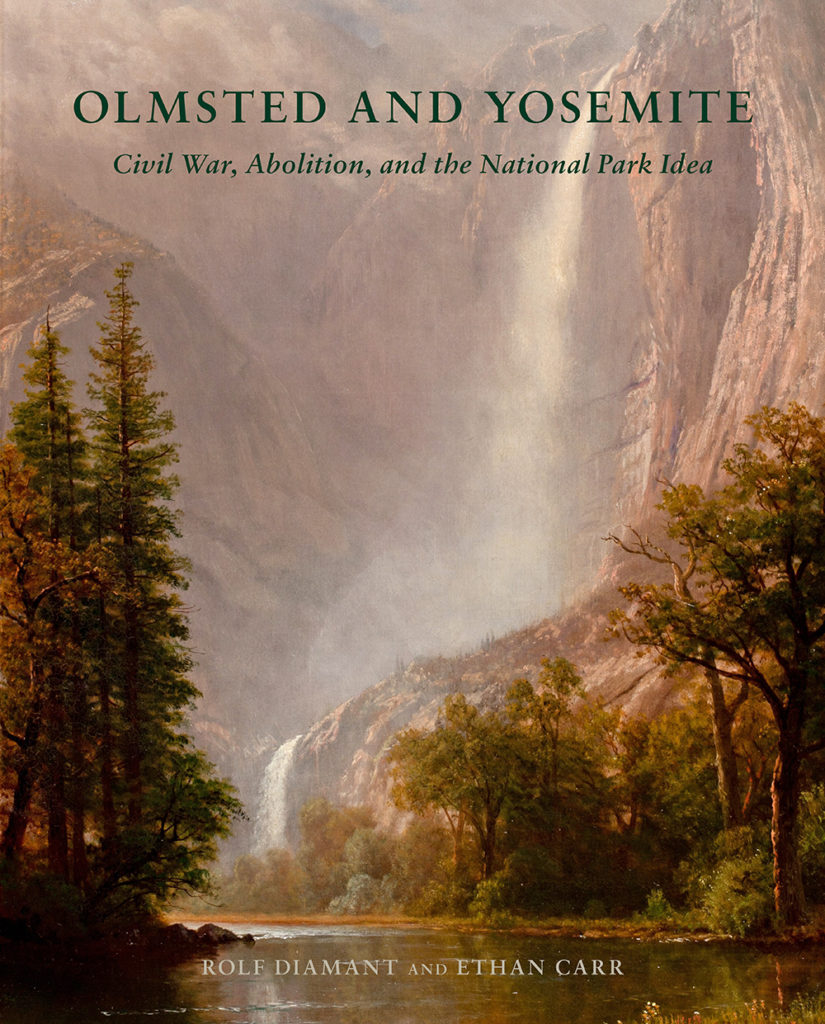Olmsted and Yosemite
Civil War, Abolition, and the National Park Idea
Rolf Diamant and Ethan Carr
| ISBN: 978-1-952620-34-8 | 192 pages | 6.125 x 9.25 inches |
| 28.00 | Cloth | Published: 03/10/2022 |
During the turbulent decade the United States engaged in a civil war, abolished slavery, and remade the government, the public park emerged as a product of these dramatic changes. New York’s Central Park and Yosemite in California both embodied the “new birth of freedom” that had inspired the Union during its greatest crisis, epitomizing the duty of republican government to enhance the lives and well-being of all its citizens. A central thread connecting abolition, the Civil War, and the dawn of urban and national parks is the life of Frederick Law Olmsted.
In 1864, Olmsted was asked to prepare a plan for a park in Yosemite Valley, created by Congress to expand the privileges of American citizenship associated with Union victory. His groundbreaking Yosemite Report effectively created an intellectual framework for a national park system. Here Olmsted expressed the core tenet of the national park idea: that the republic should provide its citizenry access to the restorative benefits of nature.
The National Park Service has been slow to embrace the senior Olmsted’s role in this history. In the early twentieth century, a period of “reconciliation” between North and South, National Park Service administrators preferred more anodyne narratives of pristine Western landscapes discovered by rugged explorers and spontaneously reimagined as national parks. They wanted a history disassociated from urban parks and the problems of industrializing cities and unburdened by the legacies of slavery and Native American dispossession.
Marking the bicentennial of Olmsted’s birth, Olmsted and Yosemite sets the historical record straight as it offers a new interpretation of how the American park—urban and national—came to figure so prominently in our cultural identity, and why telling this more complex and inclusive story is critically important.
“Framed around the abolition of slavery and questions of citizenship and nationhood in the Civil War years, Olmsted and Yosemite links landscape to ideals of freedom and government reform. The authors suggest that the birth of the National Park System . . . is an expression of equity for all.”
“It is a very confusing time in our nation right now as we see bold steps taken to eliminate factual literature from our educational institutions. It warms my heart to see you and your contemporaries not missing a beat in doing what you do.”
“What this work has revealed about the NPS origin story is so important and it brings this conversation into play with an array of new research helping to expand our understanding of our nation's history.”
“Olmsted and Yosemite is the most thought-provoking book I have read about Olmsted and the American park movement.”
“I have to share with you that this is one of the finest books I’ve ever read.”
“Olmsted and Yosemite is a truly wonderful book that deserves to be read widely by scholars, undergraduates, and the general public.”
“This book is so timely. It shows that some of the early thinkers and visionaries of our national parks were also advocates for civil rights.”
About the Authors
Rolf Diamant
Rolf Diamant is a landscape architect, adjunct associate professor of historic preservation at the University of Vermont, and former superintendent of five national parks including Frederick Law Olmsted National Historic Site. He regularly contributes to the journal Parks Stewardship Forum and is coeditor and contributing author of A Thinking Person’s Guide to America’s National Parks.
Ethan Carr
Ethan Carr, FASLA, is professor of landscape architecture at the University of Massachusetts Amherst and an international authority on America’s public landscapes. He is author of Wilderness by Design: Landscape Architecture and the National Park Service, Mission 66: Modernism and the National Park Dilemma, The Greatest Beach: A History of Cape Cod National Seashore, Boston’s Franklin Park: Olmsted, Recreation, and the Modern City, and coauthor of Olmsted and Yosemite: Civil War, Abolition, and the National Park Idea, lead editor of Public Nature: Scenery, History, and Park Design, and coeditor of Volume 8 of The Papers of Frederick Law Olmsted.
